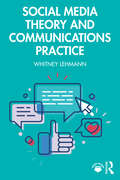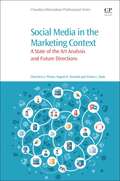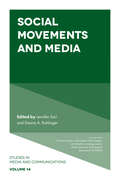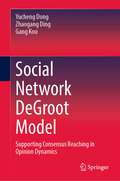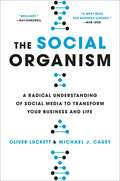- Table View
- List View
Social Media Strategy: A Practical Guide to Social Media Marketing and Customer Engagement
by Julie AthertonSocial Media Strategy provides a simple, structured way to create integrated customer engagement and social media campaigns that work. Organizations often talk of digital planning but struggle to know which channels to invest in, how to integrate them with content marketing activity, or fail to develop measurable outputs that align with business objectives. This book provides a clear road map for efficient planning, deliverance and financial accountability of social media's contribution to the business.Social Media Strategy delivers practical guidance such as identifying and targeting audience segments, methods of two-way community engagement, reputation management, being present on the right channels, and driving action through influencers. It also identifies the relevant tools and platforms to audit, track and measure business impact and customer engagement. With example templates, interviews and global case studies including National Geographic, TUI, Dreams Beds and Tiny Giant, this professional guide delivers a long-term solution for maximizing social media led business development.
Social Media Strategy in Policing: From Cultural Intelligence to Community Policing (Security Informatics and Law Enforcement)
by Babak Akhgar Petra Saskia Bayerl George LeventakisThis book addresses conceptual and practical issues pertinent to the creation and realization of social media strategies within law enforcement agencies. The book provides readers with practical methods, frameworks, and structures for understanding social media discourses within the operational remit of police forces and first responders in communities and areas of concern. This title - bridging the gap in social media and policing literature - explores and explains the role social media can play as a communication, investigation, and direct engagement tool. It is authored by a rich mix of global contributors from across the landscape of academia, policing and experts in government policy and private industry. Presents an applied look into social media strategies within law enforcement;Explores the latest developments in social media as it relates to community policing and cultural intelligence; Includes contributions and case studies from global leaders in academia, industry, and government.
Social Media Theory and Communications Practice
by Whitney LehmannFusing the academic with the applied, this book provides a comprehensive introduction to social media for future communications professionals.While most social media texts approach the subject through either a theoretical, scholarly lens or a professional, practical lens, this text offers a much-needed linkage of theory to the practical tactics employed by social media communicators. Concise and conversational chapters break down the basics of both social media theory and practice and are complemented by sidebars written by scholars and industry professionals, chapter summaries and end-of-chapter exercises.This book is ideal for introductory social media courses in communication, public relations and mass communication departments, as well as courses in digital media and public relations.Online resources include social media writing templates, sample posts and content calendar templates. Please visit www.routledge.com/9781032185873.
Social Media Theory and Communications Practice
by Whitney LehmannFusing the academic with the applied, this book provides a comprehensive introduction to social media for future communications professionals.While most social media texts approach the subject through either a theoretical, scholarly lens or a professional, practical lens, this text offers a much-needed linkage of theory to the practical tactics employed by social media communicators. Concise and conversational chapters break down the basics of both social media theory and practice and are complemented by sidebars written by scholars and industry professionals, chapter summaries and end-of-chapter exercises.This book is ideal for introductory social media courses in communication, public relations and mass communication departments, as well as courses in digital media and public relations.Online resources include social media writing templates, sample posts and content calendar templates. Please visit www.routledge.com/9781032185873.
Social Media und Wissensklüfte: Nachrichtennutzung und politische Informiertheit junger Menschen
by Patricia MüllerPatricia Müller untersucht in ihrer Studie, wie sich die Nutzung von Nachrichten im Social Web auf die politische Informiertheit junger Menschen auswirkt. Die Arbeit beleuchtet anknüpfend an die Wissenskluftforschung vielfältige Faktoren für politischen Wissenserwerb: Basierend auf einer zweiwelligen Panelbefragung 16-29-Jähriger zeigt die Autorin auf, wie Bildung, Motivation, differenzielle Nachrichtennutzung, Informationsverarbeitung sowie politische Gespräche und der Austausch über Politik auf Social Network Sites die Entwicklung von Wissensklüften beeinflussen. Darüber hinaus wird die Illusion of Knowing in den Blick genommen und analysiert, was eine Überschätzung der eigenen politischen Informiertheit begünstigen kann.
Social Media Use in Crisis and Risk Communication: Emergencies, Concerns and Awareness
by Editors Harald Hornmoen Klas BackholmCrises pose an immediate risk to life, health, and the environment and require urgent action. The public’s use of social media has important implications for contingency policies and practices. Social media have the potential for risk reduction and preventive interaction with the public. This book is about how different communicators - whether crisis managers, first responders, journalists, or private citizens and disaster victims - have used social media to communicate about risks and crises. It is also about how these very different actors can play a crucial role in mitigating or preventing crises. How can they use social media to strengthen their own and the public’s awareness and understanding of crises when they unfold? How can they use social media to promote resilience during crises and the ability to deal with the after-effects? Chapters address such questions by presenting new research-based knowledge on social media use during different crises: the terrorist attacks in Norway on 22 July 2011; the central European floods in Austria in 2013; and the West African Ebola-outbreak in 2014. The collection also presents research on the development of a tool for gathering social media information, based on a user-centered design. Social Media use in Crisis and Risk Communication presents cutting-edge research on the use of social media in crisis communication and reporting.
Social Media Use in Crisis and Risk Communication: Emergencies, Concerns and Awareness (PDF)
by Editors Harald Hornmoen Klas BackholmCrises pose an immediate risk to life, health, and the environment and require urgent action. The public’s use of social media has important implications for contingency policies and practices. Social media have the potential for risk reduction and preventive interaction with the public. This book is about how different communicators - whether crisis managers, first responders, journalists, or private citizens and disaster victims - have used social media to communicate about risks and crises. It is also about how these very different actors can play a crucial role in mitigating or preventing crises. How can they use social media to strengthen their own and the public’s awareness and understanding of crises when they unfold? How can they use social media to promote resilience during crises and the ability to deal with the after-effects? Chapters address such questions by presenting new research-based knowledge on social media use during different crises: the terrorist attacks in Norway on 22 July 2011; the central European floods in Austria in 2013; and the West African Ebola-outbreak in 2014. The collection also presents research on the development of a tool for gathering social media information, based on a user-centered design. Social Media use in Crisis and Risk Communication presents cutting-edge research on the use of social media in crisis communication and reporting.
SOCIAL MEDIA IN THE MARKETING CONTEXT: A State of the Art Analysis and Future Directions (pdf)
by Geoff Walton Woody Evans Cherniece J. Plume Yogesh K. Dwivedi Emma L. Slade9780081017548
Social Mentality and Public Opinion in China (China Perspectives)
by Fanbin ZengThis book explores the relationship between social mentality, public opinion, media, and other factors through mixed methods in China, especially since the 21st century.The book deploys qualitative and quantitative research and adopts a multi-disciplinary perspective and diversified research methods. The studies are built on and contribute to the burgeoning literature seeking to anatomize the relationship between social mentality, media, and public opinion from the point of view of sociology and communication. It also aims to explore how media can be used to appease public opinion. As the first systematic study of the interconnection between social mentality and public opinion, this book provides empirical support and a theoretical framework for both areas. It will thus be a great read for students and scholars of communication, sociology, and social psychology, especially for those with a focus on China and new media.
Social Mentality and Public Opinion in China (China Perspectives)
by Fanbin ZengThis book explores the relationship between social mentality, public opinion, media, and other factors through mixed methods in China, especially since the 21st century.The book deploys qualitative and quantitative research and adopts a multi-disciplinary perspective and diversified research methods. The studies are built on and contribute to the burgeoning literature seeking to anatomize the relationship between social mentality, media, and public opinion from the point of view of sociology and communication. It also aims to explore how media can be used to appease public opinion. As the first systematic study of the interconnection between social mentality and public opinion, this book provides empirical support and a theoretical framework for both areas. It will thus be a great read for students and scholars of communication, sociology, and social psychology, especially for those with a focus on China and new media.
Social Movements and Media (Studies in Media and Communications #14)
by Jennifer S. Earl Deana A. RohlingerSponsored by the Communication, Information Technologies, and Media Sociology section of the American Sociological Association (CITAMS), this volume focuses on media and social movements. Contributing authors draw on cases as diverse as the Harry Potter Alliance to youth oriented, non-profit educational organizations, in order to assess systematically how media environments, systems, and usage affect collective action in the 21st century. The volume demonstrates that the study of media and social movements has developed into a vibrant sub-field stretched across Communication Studies, Political Science, and Sociology, and illustrates the need for serious interdisciplinary research. Chapters in the volume reinforce the need to examine many kinds of media (such as fiction) for social movements, particularly in terms of recruitment and framing. They show the critical importance of connecting classic and contemporary social movement research when trying to understand topics such as recruitment, identity, and discourse, even when these are playing out in the digital world. Chapters explore the difficulties that organizations face in organizing whether or not they are primarily offline or online; the ways that digital media usage affects various organizational functions and effectiveness; and the importance of examining the role of youth in social movements across all of these topics.
Social Movements and Media (Studies in Media and Communications #14)
by Jennifer S. Earl Deana A. RohlingerSponsored by the Communication, Information Technologies, and Media Sociology section of the American Sociological Association (CITAMS), this volume focuses on media and social movements. Contributing authors draw on cases as diverse as the Harry Potter Alliance to youth oriented, non-profit educational organizations, in order to assess systematically how media environments, systems, and usage affect collective action in the 21st century. The volume demonstrates that the study of media and social movements has developed into a vibrant sub-field stretched across Communication Studies, Political Science, and Sociology, and illustrates the need for serious interdisciplinary research. Chapters in the volume reinforce the need to examine many kinds of media (such as fiction) for social movements, particularly in terms of recruitment and framing. They show the critical importance of connecting classic and contemporary social movement research when trying to understand topics such as recruitment, identity, and discourse, even when these are playing out in the digital world. Chapters explore the difficulties that organizations face in organizing whether or not they are primarily offline or online; the ways that digital media usage affects various organizational functions and effectiveness; and the importance of examining the role of youth in social movements across all of these topics.
Social Multimedia Signals: A Signal Processing Approach to Social Network Phenomena
by Suman Deb Roy Wenjun ZengThis book provides a comprehensive coverage of the state-of-the-art in understanding media popularity and trends in online social networks through social multimedia signals. With insights from the study of popularity and sharing patterns of online media, trend spread in social media, social network analysis for multimedia and visualizing diffusion of media in online social networks. In particular, the book will address the following important issues: Understanding social network phenomena from a signal processing point of view; The existence and popularity of multimedia as shared and social media, how content or origin of sharing activity can affect its spread and popularity; The network-signal duality principle, i.e., how the signal tells us key properties of information diffusion in networks; The social signal penetration hypothesis, i.e., how the popularity of media in one domain can affect the popularity of media in another. The book will help researchers, developers and business (advertising/marketing) individuals to comprehend the potential in exploring social multimedia signals collected from social network data quantitatively from a signal processing perspective.
The Social Nature of Antibiotic Overprescription in China: Medical Conversations, Doctor–Patient Relationships, and Decision-Making (Routledge Studies in Language, Health and Culture)
by Nan Christine WangOffering a rarely seen glimpse into the realities of one of the biggest global public health crises in modern time, Wang’s book focuses on doctor–patient interactions in China to demonstrate the potential effects of health communication, doctor–patient relationship, and a matrix of social factors on overprescription of antibiotics.Based on a community-based survey, the book describes empirical findings regarding the high prevalence of non-prescribed antibiotics use for common colds among children in China. It covers the potential effects of overprescription on caregivers' attitudes and how physicians make prescribing decisions in medical consultations. Drawing from evidence in medical interaction data, readers are introduced to further empirical findings regarding the communicative behaviors that patient caregivers use to pressure for antibiotic prescriptions in real medical consultations. Following this, Wang reports findings regarding the communicative behaviors that physicians use to make treatment recommendations and caregivers use to launch treatment negotiations, leading to a discussion of the effect of the doctor–patient relationship on antibiotic overprescription. The book culminates in practice recommendations and provides teaching scenarios in which physicians successfully engage the caregivers into conversations to shape their expectations for antibiotic prescriptions in medical consultations.An important resource for scholars and students in health communication, linguistics, medical humanities, and medical sociology. Practitioners who are interested in understanding and improving clinical practices as well as policymakers aiming to combat antibiotic resistance will also find this book useful.
The Social Nature of Antibiotic Overprescription in China: Medical Conversations, Doctor–Patient Relationships, and Decision-Making (Routledge Studies in Language, Health and Culture)
by Nan Christine WangOffering a rarely seen glimpse into the realities of one of the biggest global public health crises in modern time, Wang’s book focuses on doctor–patient interactions in China to demonstrate the potential effects of health communication, doctor–patient relationship, and a matrix of social factors on overprescription of antibiotics.Based on a community-based survey, the book describes empirical findings regarding the high prevalence of non-prescribed antibiotics use for common colds among children in China. It covers the potential effects of overprescription on caregivers' attitudes and how physicians make prescribing decisions in medical consultations. Drawing from evidence in medical interaction data, readers are introduced to further empirical findings regarding the communicative behaviors that patient caregivers use to pressure for antibiotic prescriptions in real medical consultations. Following this, Wang reports findings regarding the communicative behaviors that physicians use to make treatment recommendations and caregivers use to launch treatment negotiations, leading to a discussion of the effect of the doctor–patient relationship on antibiotic overprescription. The book culminates in practice recommendations and provides teaching scenarios in which physicians successfully engage the caregivers into conversations to shape their expectations for antibiotic prescriptions in medical consultations.An important resource for scholars and students in health communication, linguistics, medical humanities, and medical sociology. Practitioners who are interested in understanding and improving clinical practices as well as policymakers aiming to combat antibiotic resistance will also find this book useful.
Social Navigation of Information Space (Computer Supported Cooperative Work)
by Alan J. Munro Kristina Höök David BenyonThis volume examines how people deal with information in a computerized environment, looking at what happens when people actively explore information space looking for objects without specific goals in mind. The topics are particularly relevant to the industrial application of computer supported cooperative work (CSCW) techniques, especially with regard to teleworking and virtual organizations. This volume will be useful for researchers interested in human computer interaction, virtual communities, and information visualization.
Social Network Analysis with Applications
by Ian McCulloh Helen Armstrong Anthony JohnsonA comprehensive introduction to social network analysis that hones in on basic centrality measures, social links, subgroup analysis, data sources, and more Written by military, industry, and business professionals, this book introduces readers to social network analysis, the new and emerging topic that has recently become of significant use for industry, management, law enforcement, and military practitioners for identifying both vulnerabilities and opportunities in collaborative networked organizations. Focusing on models and methods for the analysis of organizational risk, Social Network Analysis with Applications provides easily accessible, yet comprehensive coverage of network basics, centrality measures, social link theory, subgroup analysis, relational algebra, data sources, and more. Examples of mathematical calculations and formulas for social network measures are also included. Along with practice problems and exercises, this easily accessible book covers: The basic concepts of networks, nodes, links, adjacency matrices, and graphs Mathematical calculations and exercises for centrality, the basic measures of degree, betweenness, closeness, and eigenvector centralities Graph-level measures, with a special focus on both the visual and numerical analysis of networks Matrix algebra, outlining basic concepts such as matrix addition, subtraction, multiplication, and transpose and inverse calculations in linear algebra that are useful for developing networks from relational data Meta-networks and relational algebra, social links, diffusion through networks, subgroup analysis, and more An excellent resource for practitioners in industry, management, law enforcement, and military intelligence who wish to learn and apply social network analysis to their respective fields, Social Network Analysis with Applications is also an ideal text for upper-level undergraduate and graduate level courses and workshops on the subject.
Social Network Analysis with Applications
by Ian McCulloh Helen Armstrong Anthony JohnsonA comprehensive introduction to social network analysis that hones in on basic centrality measures, social links, subgroup analysis, data sources, and more Written by military, industry, and business professionals, this book introduces readers to social network analysis, the new and emerging topic that has recently become of significant use for industry, management, law enforcement, and military practitioners for identifying both vulnerabilities and opportunities in collaborative networked organizations. Focusing on models and methods for the analysis of organizational risk, Social Network Analysis with Applications provides easily accessible, yet comprehensive coverage of network basics, centrality measures, social link theory, subgroup analysis, relational algebra, data sources, and more. Examples of mathematical calculations and formulas for social network measures are also included. Along with practice problems and exercises, this easily accessible book covers: The basic concepts of networks, nodes, links, adjacency matrices, and graphs Mathematical calculations and exercises for centrality, the basic measures of degree, betweenness, closeness, and eigenvector centralities Graph-level measures, with a special focus on both the visual and numerical analysis of networks Matrix algebra, outlining basic concepts such as matrix addition, subtraction, multiplication, and transpose and inverse calculations in linear algebra that are useful for developing networks from relational data Meta-networks and relational algebra, social links, diffusion through networks, subgroup analysis, and more An excellent resource for practitioners in industry, management, law enforcement, and military intelligence who wish to learn and apply social network analysis to their respective fields, Social Network Analysis with Applications is also an ideal text for upper-level undergraduate and graduate level courses and workshops on the subject.
Social Network DeGroot Model: Supporting Consensus Reaching in Opinion Dynamics
by Gang Kou Yucheng Dong Zhaogang DingThis book investigates the DeGroot model in social network contexts, and proposes the social network DeGroot (SNDG) model. Specifically, this book focuses on two core research problems in the SNDG model: (i) Social network structures to reach a stable state (consensus, polarization, or fragmentation); and (ii) the convergence rate to reach a stable state. Furthermore, the authors generalize the SNDG model in an uncertain context, showing the effects of interval opinions on the SNDG model. In this book, the authors also discuss the applications of the SNDG model to support group decision making, including consensus reaching through adding minimum interactions, trust relationships manipulations, and risk control issues in the social network. Apart from theoretical analysis, detailed experimental simulations with real and random data will be applied to validate our research.This book is the first to connect opinion dynamics, social network and group decision making. The resultsreported can help us understand the evolution of public opinions in social network contexts and provide new tools to support consensus reaching in group decision making.
Social Networking and Computational Intelligence: Proceedings of SCI-2018 (Lecture Notes in Networks and Systems #100)
by Rajesh Kumar Shukla Jitendra Agrawal Sanjeev Sharma Narendra S. Chaudhari K. K. ShuklaThis book presents a selection of revised and extended versions of the best papers from the First International Conference on Social Networking and Computational Intelligence (SCI-2018), held in Bhopal, India, from October 5 to 6, 2018. It discusses recent advances in scientific developments and applications in these areas.
Social Networking Approach to Japanese Language Teaching: The Intersection of Language and Culture in the Digital Age
by Yasu-Hiko TohsakuSocial Networking Approach to Japanese Language Teaching is a timely guide for Japanese language teachers and anyone interested in language pedagogy. The book outlines an innovative approach to language instruction which goes beyond the communicative approach and encourages a global view of language education and curriculum development through the use of social networking. It showcases diverse examples of how social networking can be harnessed and incorporated into everyday language classes to increase learners’ curiosity and engagement in real cultural and global interactions. While the focus is on Japanese language teaching, the concepts explored can be applied to other languages and teaching contexts. This book will benefit teachers of any language as well as linguists interested in language pedagogy.
Social Networking Approach to Japanese Language Teaching: The Intersection of Language and Culture in the Digital Age
by Yasu-Hiko Tohsaku Fumiko Nazikian Jisuk ParkSocial Networking Approach to Japanese Language Teaching is a timely guide for Japanese language teachers and anyone interested in language pedagogy. The book outlines an innovative approach to language instruction which goes beyond the communicative approach and encourages a global view of language education and curriculum development through the use of social networking. It showcases diverse examples of how social networking can be harnessed and incorporated into everyday language classes to increase learners’ curiosity and engagement in real cultural and global interactions. While the focus is on Japanese language teaching, the concepts explored can be applied to other languages and teaching contexts. This book will benefit teachers of any language as well as linguists interested in language pedagogy.
Social News: How Born-Digital Outlets Transformed Journalism
by Edward HurcombeThis book is the first to define and describe ‘social news’, a new kind of journalism emerging in response to social media. Drawing on the author’s extensive research into news and social media platforms, Social News critically examines the rise of well-known outlets such as BuzzFeed and Mic in the US, and Junkee and Pedestrian in Australia. Hurcombe argues that these outlets became successful by strategically engaging with social media, producing sociable content personalised for millennials. Such outlets have been criticised for violating the rules of ‘quality’ journalism. However, this book shows how social news has provided a platform for marginalised voices and has been able to engage readers neglected by legacy news. While social media is frequently seen as a threat to the news industry, Social News shows that digital platforms have been driving new forms of journalism: ones that challenge our understanding of what journalism is, can be, and should be.
The Social Organism: A Radical Understanding of Social Media to Transform Your Business and Life
by Michael Casey Oliver Luckett"A must-read for business leaders and anyone who wants to understand all the implications of a social world."---Bob Iger, Chairman and Chief Executive Officer of The Walt Disney CompanyFrom tech visionaries Oliver Luckett and Michael J. Casey, a groundbreaking, must-read theory of social media--how it works, how it's changing human life, and how we can master it for good and for profit.In barely a decade, social media has positioned itself at the center of twenty-first century life. The combined power of platforms like Facebook, Twitter, Instagram, Snapchat, and Vine have helped topple dictators and turned anonymous teenagers into celebrities overnight. In the social media age, ideas spread and morph through shared hashtags, photos, and videos, and the most compelling and emotive ones can transform public opinion in mere days and weeks, even attitudes and priorities that had persisted for decades. How did this happen? The scope and pace of these changes have left traditional businesses--and their old-guard marketing gatekeepers--bewildered. We simply do not comprehend social media's form, function, and possibilities. It's time we did.In The Social Organism, Luckett and Casey offer a revolutionary theory: social networks--to an astonishing degree--mimic the rules and functions of biological life. In sharing and replicating packets of information known as memes, the world's social media users are facilitating an evolutionary process just like the transfer of genetic information in living things. Memes are the basic building blocks of our culture, our social DNA. To master social media--and to make online content that impacts the world--you must start with the Social Organism.With the scope and ambition of The Second Machine Age and James Gleick's The Information, The Social Organism is an indispensable guide for business leaders, marketing professionals, and anyone serious about understanding our digital world--a guide not just to social media, but to human life today and where it is headed next.
Social Photography: Make All Your Smartphone Photos One in a Billion
by Daniela BowkerHot photo apps come and go, but the practice of shooting and sharing is universal and is now a fundamental part of the way that we communicate with each other. Photos aren't printed on paper anymore - they are displayed on screens; and everywhere they are shown, the viewer is invited to like or share. Social Photography will show you how to create photos that will be clicked on, liked, shared, and - if you want - go viral. A must-read for anyone who takes their online presence seriously, this book will show you how to give your photos a fresh look, give you hundreds of posing and shooting ideas, and let you share your life's most exciting moments wider than ever before.


